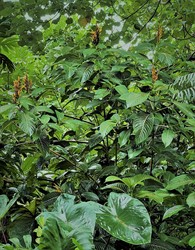- Worldwide distribution. In Australia, Cook Islands, FSM, New Caledonia, Niue, Palau, Tonga.
- Invasive tropics and subtropics. Dense stands in moist to wet native and secondary forests, forest edges, along streams, rivers. Especially in lowland areas, up to 1000 masl. Biodiversity threat to native forests.
- Erect shrub to 2 m. Stem 4-angled, leaves opposite, oval, large, white mid-ribs, characteristic white/yellow veins. Flowers, in clusters, red leaf-like calyx around 4-5 cm yellow/orange tube with two protruding stamens.
- Spread: vegetateivly propagated. Vine pieces in garden waste, moving water. Not seeds. Via international trade as an ornamental.
- Biosecurity: high risk; garden and house plant; available on Internet.
- Natural enemies: none.
- Cultural: hand-pulling; collect stem pieces and burn. Avoid using topsoil where grown previously.
- Chemical control: In Australia, fluroxypyr; triclopyr + picloram; triclopyr + picloram + aminopyralid. Permit for non-agricultural areas, domestic and commercial spaces, bushland, native forests, roadsides, wastelands, wetlands, and coastal.






